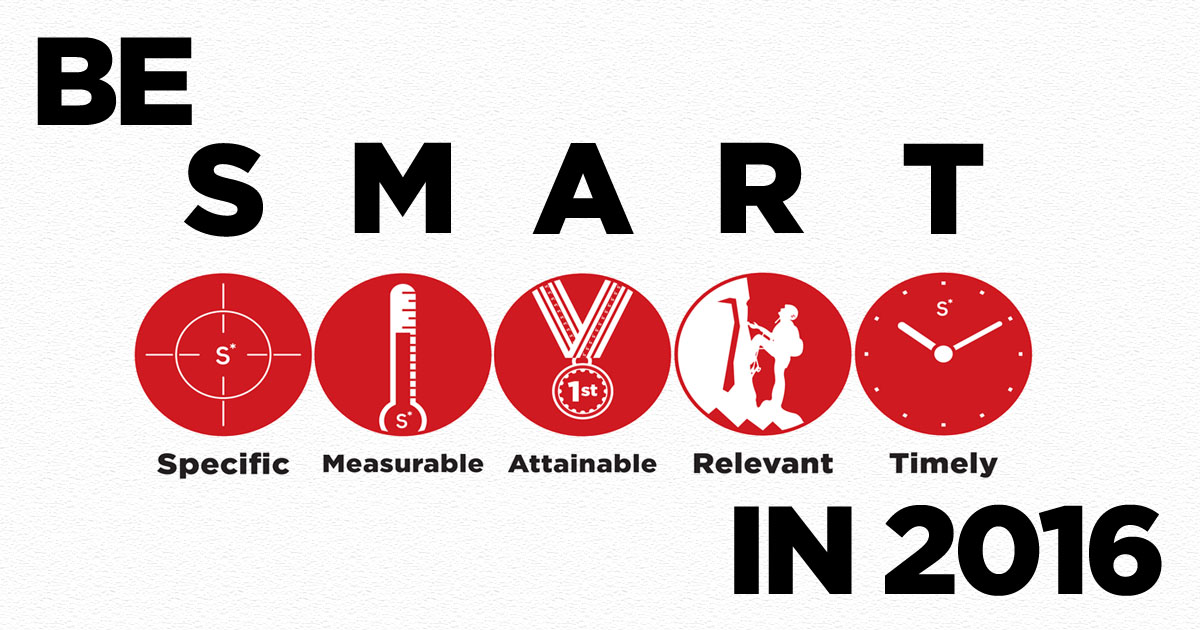
If you’re implementing an inbound marketing strategy for the first time in 2016, or if you’ve been running inbound campaigns for years, you’ll want a way to measure your success. One way to do that is to set up realistic goals and monitor them throughout the year. The SMART goal-setting method can help you and your company set goals that can be evaluated over the course of the year.
Specific
I want to increase the number of visitors to our company website
The first step in SMART goal setting is to make the goal as specific as possible. Do you want to increase visitors, leads, or customers? The answer might be all three, but work to separate out the goals to make them easier to achieve and see grow. In this example, the goal is to increase visitors to the site. To increase visitors to the site, what must you do or add to your strategy to achieve this goal?
One way is to increase social media posts leading back to the site. A consistent social media presence is important to any inbound strategy, especially in increasing visibility to your brand, and your site.
Measurable
I want to increase the number of visitors to our company website by 10%, or 500 visitors
Next, make your goal measurable. Don’t just say “increase” but add a concrete number or percentage. Adding a concrete number allows you to compare to past numbers, benchmark progress, and evaluate growth along the way.
Creating content, such as blog posts, can be a way to increase visitors (which will turn into leads, then customers) to your site. By creating educational and informational content about your industry, you become a trusted expert in your field, leading your audience to turn to you when they need help.
Attainable
I want to increase the number of visitors to our company website by 10%, or 500 visitors, based on the average growth rate of 7%
Base your goal on past data. Know how much you’ve grown in this area for the last few months, quarters, or years and know how much your business is capable of growing. Be realistic in how much your company can stand to grow right now. Don’t attempt to scale your business to be bigger than what it can handle.
To understand what your company can handle, look to Google Analytics or HubSpot’s report features. These resources can tell you how visitors, leads, and customers have grown month over month and year over year to give you a picture of where your company is and where it can go.
Relevant
I want to increase the number of visitors to our company website by 10%, or 500 visitors, based on the average growth rate of 7%, which will fit into the company goal of increasing our leads based on our 1% visitor-to-lead conversion rate
When creating SMART goals, it’s important to be specific while also keeping in mind the bigger goals and objectives of the company. The bigger goal might be to increase customers, which rely on increased leads, which rely on increased site visitors. What will it take to increase customers? An increase of site visitors. From there, each goal can be broken down further into what it takes to accomplish that specific goal, which ultimately fits into the bigger company goal.
Content can also be copy on landing pages and attached offers. These help visitors who are interested learn more about you and allow you to learn more about those who are closer and closer to buying your product or service. Content like this can help bridge one SMART goal to another.
Timely
I want to increase the number of visitors to our company website by 10%, or 500 visitors, based on the average growth rate of 7%, which will fit into the company goal of increasing our leads based on our 1% visitor-to-lead conversion rate, by the end of the first quarter.
It’s important to add a timeline and deadline to your goal. It will allow you to be accountable to this goal at the end of the time period, while also allowing you to monitor progress throughout to adjust the strategy to meet the goal. It helps interconnected goals stay on track and concentrates the marketing efforts into a constrained period of time instead of allowing the goal to hang over your head for an indefinite period of time.
Google Analytics and HubSpot reports can help with monitoring the goal throughout the time period, just like they help you create attainable goals. While you concentrate on creating new content, like social media posts, blog posts, and content offers, you can also set up marketing automation using emails and workflows to be able to feed people down the sales funnel using content you’ve already created. It works in the background with past campaigns, allowing you to focus on growing your company without missing a beat.
SMART goals allow big, long-term goals to be easily understood across the company hierarchy, while also easily breaking down into smaller SMART goals for different departments or different time frames. Download the free SMART Goal Template to get started on your goals for 2016 and beyond.
{{cta(‘b569724a-1258-4c74-9724-29ec1ceaa309’)}}
